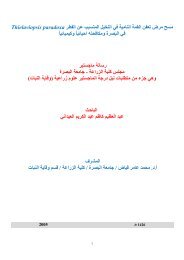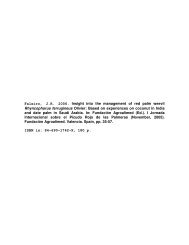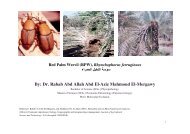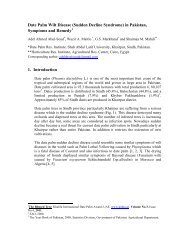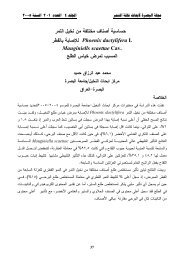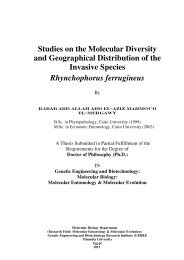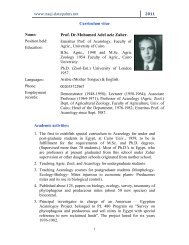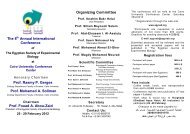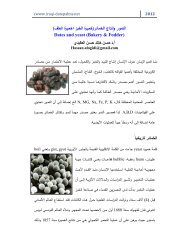The red palm weevil as an alien invasive: biology and the prospects ...
The red palm weevil as an alien invasive: biology and the prospects ...
The red palm weevil as an alien invasive: biology and the prospects ...
Create successful ePaper yourself
Turn your PDF publications into a flip-book with our unique Google optimized e-Paper software.
42N BiocontrolNews <strong>an</strong>d Information 1999 Vol. 20 No. 1<br />
IPM <strong>an</strong>d <strong>the</strong> Prospects for Biological Control<br />
Current methods of control<br />
<strong>The</strong> methods currently employed to control <strong>red</strong> <strong>palm</strong> <strong>weevil</strong> are<br />
largely b<strong>as</strong>ed on <strong>the</strong> application of large qu<strong>an</strong>tities of syn<strong>the</strong>tic<br />
chemical insecticides (Abuzuhairah et al., 1996) which, applied in<br />
<strong>the</strong> conditions of <strong>the</strong> s<strong>an</strong>dy soils of <strong>the</strong> Gulf, h<strong>as</strong> lead to <strong>the</strong> pollution<br />
of water courses around are<strong>as</strong> with <strong>palm</strong> <strong>weevil</strong> infestation (R. A.<br />
Abuzuhairah, pers. comm.). Insecticides are also commonly used in<br />
Central <strong>an</strong>d South America for <strong>the</strong> control of R. <strong>palm</strong>arum (e.g.<br />
Moura et al., 1995). However, o<strong>the</strong>r techniques of m<strong>an</strong>agement<br />
such <strong>as</strong> s<strong>an</strong>itation, baits <strong>an</strong>d traps of <strong>palm</strong> <strong>weevil</strong>s have been<br />
researched in tropical Asia (particularly India) <strong>an</strong>d <strong>the</strong> Americ<strong>as</strong>,<br />
<strong>an</strong>d when used in combination with chemicals have proved<br />
effective in field trials (Abraham et al., 1989; Moura et al., 1995).<br />
We first review some of <strong>the</strong>se o<strong>the</strong>r techniques before considering<br />
<strong>the</strong> <strong>prospects</strong> for biological control in IPM.<br />
Insecticides<br />
Insecticides are applied in a r<strong>an</strong>ge of preventative <strong>an</strong>d curative<br />
procedures designed to limit <strong>an</strong>d contain <strong>the</strong> spread of <strong>an</strong><br />
infestation. <strong>The</strong>se procedures have been developed <strong>an</strong>d refined<br />
since commencing in India in <strong>the</strong> 1970s when work on application<br />
of org<strong>an</strong>ophosphates <strong>an</strong>d carbamates ensu<strong>red</strong> <strong>the</strong>se chemicals<br />
became <strong>the</strong> mainstay of <strong>the</strong> chemical approach to control. Methods<br />
employed have r<strong>an</strong>ged from <strong>the</strong> precise, such <strong>as</strong> dusting of <strong>the</strong> leaf<br />
axils after pruning, to more general spraying or soaking of <strong>the</strong> tree<br />
trunk, to <strong>the</strong> direct injection of chemicals into <strong>the</strong> trunk of date or<br />
o<strong>the</strong>r <strong>palm</strong>s.<br />
<strong>The</strong> choice of chemicals now regularly used in <strong>the</strong> field developed<br />
through laboratory work on promising compounds. For example,<br />
Abraham et al. (1975) tested seven insecticides in <strong>the</strong> laboratory.<br />
<strong>The</strong> three insecticides with <strong>the</strong> lowest LC 90 s (dichlorvos,<br />
trichlorphon <strong>an</strong>d propoxur) were <strong>the</strong>n tested in <strong>the</strong> field on naturally<br />
infested coconut <strong>palm</strong>s in Kerala, India, where trichlorphon gave<br />
<strong>the</strong> best control, with 92% of <strong>the</strong> infested <strong>palm</strong>s recovering from<br />
<strong>weevil</strong> infestation. Sevin or carbaryl h<strong>as</strong> also seen regular field use<br />
in Indonesia following similar laboratory tests <strong>an</strong>d w<strong>as</strong> found to<br />
give effective field control if applied continually every two months<br />
(Soenardi et al., 1978).<br />
Direct injection of insecticide into <strong>the</strong> trunk of <strong>the</strong> coconut <strong>palm</strong> w<strong>as</strong><br />
firstreportedbyRaoet al. (1973). <strong>The</strong>y demonstrated that <strong>the</strong> direct<br />
injection of 0.2% fenthion gave effective control of larvae in <strong>the</strong><br />
tree. This work w<strong>as</strong> developed by Muthuram<strong>an</strong> (1984) who<br />
demonstrated that 10 ml of monocrotophos, or <strong>the</strong> same volume of<br />
a combination of monocrotophos <strong>an</strong>d dichlorvos (5 + 5 ml), when<br />
injected into a pre-drilled 10-cm-deep hole above <strong>the</strong> infestation<br />
site, gave good control of R. ferrugineus. Tree recovery w<strong>as</strong><br />
recorded <strong>as</strong> being 100% after this treatment. <strong>The</strong> most recent <strong>an</strong>d<br />
relev<strong>an</strong>t publication on <strong>the</strong> injection method w<strong>as</strong> carried out in<br />
United Arab Emirates by El-Ezaby (1997) who investigated control<br />
of <strong>red</strong> <strong>palm</strong> <strong>weevil</strong> under both laboratory <strong>an</strong>d field conditions.<br />
Under laboratory conditions he studied <strong>the</strong> effect of certain<br />
insecticides on larval, pupal <strong>an</strong>d adult stages <strong>an</strong>d high mortality w<strong>as</strong><br />
obtained with <strong>the</strong> insecticides carbosulf<strong>an</strong>, pirimiphos-ethyl <strong>an</strong>d<br />
‘Rogodial’. In a subsequent field experiment concentrated<br />
insecticides were injected into small date <strong>palm</strong>s that had previously<br />
been artificially infested with <strong>red</strong> <strong>palm</strong> <strong>weevil</strong> larvae. High<br />
mortality w<strong>as</strong> obtained with all three insecticides. Date <strong>palm</strong>s were<br />
injected with <strong>the</strong>se insecticides in <strong>the</strong> field <strong>as</strong> part of <strong>an</strong> integrated<br />
pest m<strong>an</strong>agement approach <strong>an</strong>d <strong>the</strong> treatment w<strong>as</strong> reported <strong>as</strong> being<br />
98% successful.<br />
An alternative to directly injecting insecticides into <strong>the</strong> tree is to seal<br />
inside <strong>the</strong> tree a tablet form of a slow rele<strong>as</strong>e fumig<strong>an</strong>t. Phostoxin<br />
tablets (aluminium phosphide) applied at a rate of at 0.5-1 tablet/tree<br />
were effective in controlling larvae, pupae <strong>an</strong>d adults of R.<br />
ferrugineus on coconut (Rao et al., 1973). Muthuram<strong>an</strong> (1984)<br />
alternatively used two 3-g Celphos (aluminium phosphide) tablets<br />
crushed <strong>an</strong>d placed in holes in date <strong>palm</strong>. All holes were <strong>the</strong>n sealed<br />
with a p<strong>as</strong>te of cement <strong>an</strong>d copper oxychloride to contain <strong>the</strong> highly<br />
toxic phosphine g<strong>as</strong> rele<strong>as</strong>ed by <strong>the</strong> tablets.<br />
<strong>The</strong> field application of insecticide to cut leaf petioles followed on<br />
from <strong>the</strong> work of Abraham (1971) who found that leaves cut at <strong>the</strong><br />
time of pruning at a point beyond <strong>the</strong> region where leaflets emerge<br />
at <strong>the</strong> b<strong>as</strong>e prevented larvae, hatching from eggs laid at <strong>the</strong> cut ends<br />
of petioles, from making <strong>the</strong>ir way into <strong>the</strong> trunk before <strong>the</strong> petiole<br />
stump dried. <strong>The</strong> rationale behind this finding w<strong>as</strong> extended to<br />
include <strong>the</strong> prophylactic practice of treating <strong>the</strong> wounds in <strong>the</strong> trees<br />
with a repellent <strong>an</strong>d by filling <strong>the</strong> leaf axils with dusts of BHC or<br />
chlord<strong>an</strong>e mixed with s<strong>an</strong>d <strong>as</strong> reported by But<strong>an</strong>i (1975). Abraham<br />
et al. (1989) have since developed this approach into <strong>an</strong> integrated<br />
system of pest m<strong>an</strong>agement for R. ferrugineus for coconut <strong>palm</strong>s by<br />
combining this use of chemicals with <strong>the</strong> improved pl<strong>an</strong>t <strong>an</strong>d field<br />
s<strong>an</strong>itation in Kerala, India, which resulted in <strong>an</strong> initial level of<br />
infestation of 69 out of 1005 young <strong>palm</strong>s in 1970 being <strong>red</strong>uced to<br />
almost to zero by 1982.<br />
Fur<strong>the</strong>r refinement of application methods h<strong>as</strong> been reported by<br />
Abraham et al. (1998) who have demonstrated that soaking of trees<br />
in insecticides such <strong>as</strong> chlorpyriphos <strong>an</strong>d endosulf<strong>an</strong> is <strong>an</strong> effective<br />
preventative me<strong>as</strong>ure. <strong>The</strong> absorption of insecticide by <strong>the</strong> matted<br />
fibre on <strong>the</strong> tree gives protection to <strong>the</strong> cracks <strong>an</strong>d crevices on <strong>the</strong><br />
tree that are favou<strong>red</strong> by <strong>the</strong> <strong>weevil</strong> for egg laying. <strong>The</strong> chemicals<br />
are now applied with <strong>an</strong> adapted soaking l<strong>an</strong>ce that drenches <strong>the</strong><br />
<strong>palm</strong> in a more accurate m<strong>an</strong>ner th<strong>an</strong> conventional sprayers.<br />
Baiting <strong>an</strong>d trapping<br />
Baiting <strong>an</strong>d trapping of <strong>weevil</strong>s uses a mixture of materials that are<br />
available to <strong>the</strong> smallholder <strong>an</strong>d <strong>the</strong> commercial farmer. A trap<br />
receptacle such <strong>as</strong> a pl<strong>as</strong>tic bucket containing host pl<strong>an</strong>t material<br />
producing fermenting pl<strong>an</strong>t volatiles plus a qu<strong>an</strong>tity of syn<strong>the</strong>tic<br />
aggregation pheromone is known to attract <strong>palm</strong> <strong>weevil</strong>s (El-Garhy,<br />
1996). It h<strong>as</strong> been established that pl<strong>an</strong>t kairomones strongly<br />
enh<strong>an</strong>ce pheromone attractiveness but when <strong>the</strong> volatiles have been<br />
identified, such <strong>as</strong> ethyl acetate, ethyl propionate or ethyl butyrate,<br />
<strong>an</strong>d added to a pheromone trap <strong>the</strong> synergistic effect is not <strong>as</strong> great<br />
<strong>as</strong> when naturally fermenting pl<strong>an</strong>t tissue is used (Giblin-Davis et<br />
al., 1996). Much work h<strong>as</strong> been conducted on <strong>the</strong> use of pheromone<br />
traps to capture <strong>an</strong>d monitor <strong>weevil</strong> populations over <strong>the</strong> l<strong>as</strong>t ten<br />
years in Asia <strong>an</strong>d <strong>the</strong> Americ<strong>as</strong> (Gunawardena & Herath, 1995;<br />
Oehlschlager et al., 1995) <strong>an</strong>d this in turn h<strong>as</strong> lead to <strong>the</strong> chemical<br />
structure of m<strong>an</strong>y species-specific pheromones being elucidated<br />
(Morin et al., 1997). <strong>The</strong> study of orientation behaviour of foraging<br />
<strong>weevil</strong>s to semiochemical devices h<strong>as</strong> helped to design <strong>an</strong>d test<br />
traps for <strong>weevil</strong> capture (Giblin-Davis et al., 1996).<br />
Palm <strong>weevil</strong> pheromones comprise eight to ten carbon secondary<br />
alcohols, <strong>an</strong>d (4S, 5S)-4-methyl-5-non<strong>an</strong>ol, known colloquially <strong>as</strong><br />
ferrugineol, is <strong>the</strong> major aggregation pheromone for R. ferrugineus.<br />
Interestingly, R. vulneratus <strong>an</strong>d R. bilineatus <strong>an</strong>d <strong>the</strong> <strong>weevil</strong>s<br />
Metam<strong>as</strong>ius hemipterus (L.) <strong>an</strong>d Dynamis bor<strong>as</strong>si (F.) (Col.,<br />
Curculionidae) are also attracted by <strong>the</strong> same compound (Giblin-<br />
Davis et al., 1996). Syn<strong>the</strong>tic versions of <strong>the</strong>se naturally occurring<br />
compounds are now included in experimental <strong>an</strong>d commercially<br />
available traps. Generally only a few milligrams per day of a<br />
syn<strong>the</strong>tic pheromone plus insecticide-treated pl<strong>an</strong>t tissue constitute<br />
very attractive <strong>an</strong>d effective trap baits (Giblin-Davis et al., 1994).<br />
Potential exists for pheromone-b<strong>as</strong>ed m<strong>as</strong>s-trapping of <strong>weevil</strong>s both<br />
to <strong>red</strong>uce <strong>the</strong>ir populations <strong>an</strong>d for monitoring <strong>the</strong>ir population<br />
dynamics to facilitate pest m<strong>an</strong>agement decisions. More work needs<br />
to be done on optimizing <strong>the</strong> use of <strong>the</strong>se traps under field



